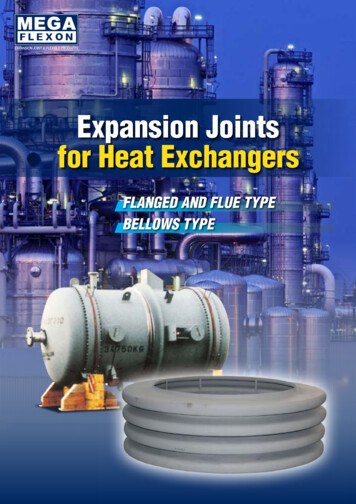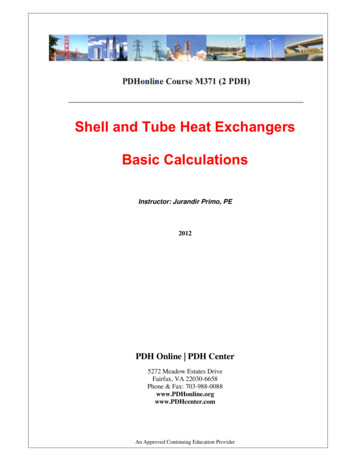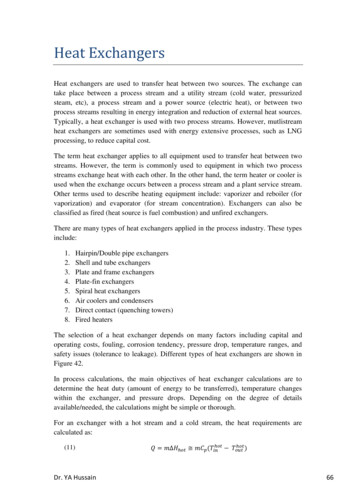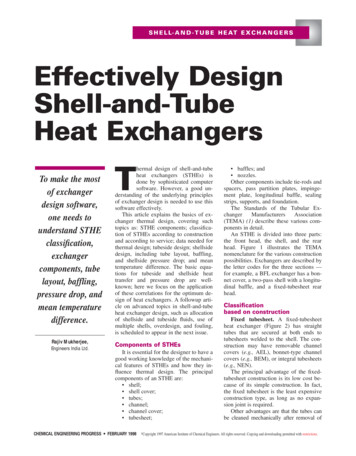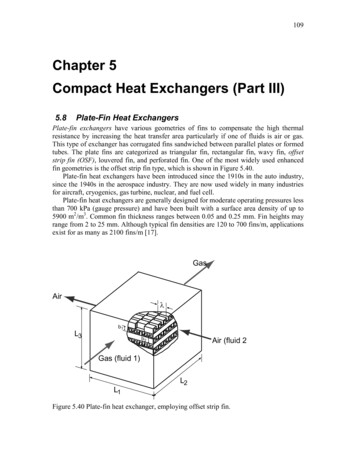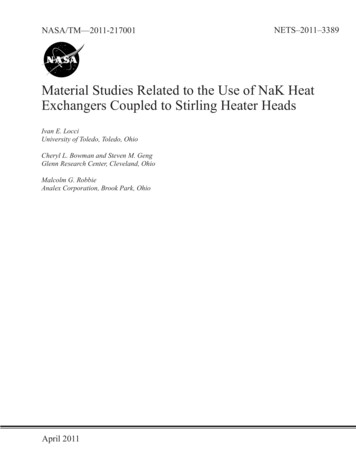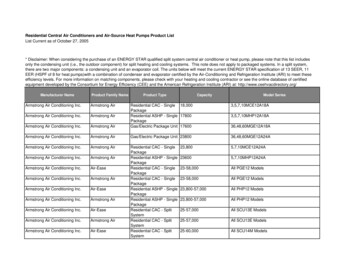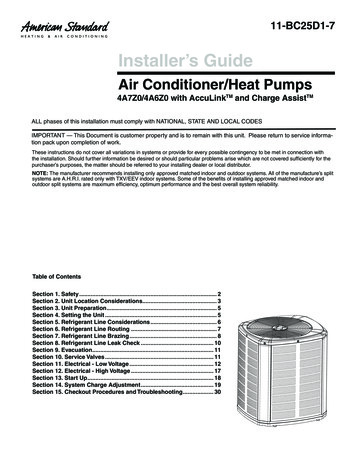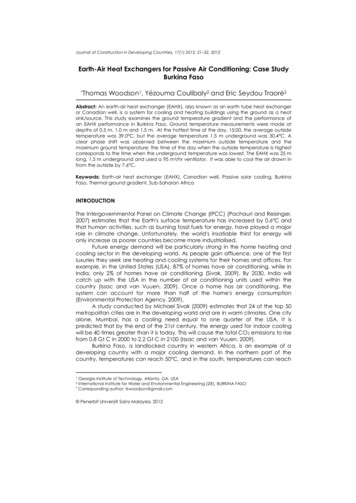
Transcription
Journal of Construction in Developing Countries, 17(1) 2012, 21–32, 2012Earth-Air Heat Exchangers for Passive Air Conditioning: Case StudyBurkina Faso*ThomasWoodson1, Yézouma Coulibaly2 and Eric Seydou Traoré2Abstract: An earth-air heat exchanger (EAHX), also known as an earth tube heat exchangeror Canadian well, is a system for cooling and heating buildings using the ground as a heatsink/source. This study examines the ground temperature gradient and the performance ofan EAHX performance in Burkina Faso. Ground temperature measurements were made atdepths of 0.5 m, 1.0 m and 1.5 m. At the hottest time of the day, 15:00, the average outsidetemperature was 39.0 C, but the average temperature 1.5 m underground was 30.4 C. Aclear phase shift was observed between the maximum outside temperature and themaximum ground temperature: the time of the day when the outside temperature is highestcorresponds to the time when the underground temperature was lowest. The EAHX was 25 mlong, 1.5 m underground and used a 95 m3/hr ventilator. It was able to cool the air drawn infrom the outside by 7.6 C.Keywords: Earth-air heat exchanger (EAHX), Canadian well, Passive solar cooling, BurkinaFaso, Thermal ground gradient, Sub-Saharan AfricaINTRODUCTIONThe Intergovernmental Panel on Climate Change (IPCC) (Pachauri and Reisinger,2007) estimates that the Earth's surface temperature has increased by 0.6 C andthat human activities, such as burning fossil fuels for energy, have played a majorrole in climate change. Unfortunately, the world's insatiable thirst for energy willonly increase as poorer countries become more industrialised.Future energy demand will be particularly strong in the home heating andcooling sector in the developing world. As people gain affluence, one of the firstluxuries they seek are heating and cooling systems for their homes and offices. Forexample, in the United States (USA), 87% of homes have air conditioning, while inIndia, only 2% of homes have air conditioning (Sivak, 2009). By 2030, India willcatch up with the USA in the number of air conditioning units used within thecountry (Issac and van Vuuen, 2009). Once a home has air conditioning, thesystem can account for more than half of the home's energy consumption(Environmental Protection Agency, 2009).A study conducted by Michael Sivak (2009) estimates that 24 of the top 50metropolitan cities are in the developing world and are in warm climates. One cityalone, Mumbai, has a cooling need equal to one quarter of the USA. It ispredicted that by the end of the 21st century, the energy used for indoor coolingwill be 40 times greater than it is today. This will cause the total CO 2 emissions to risefrom 0.8 Gt C in 2000 to 2.2 Gt C in 2100 (Issac and van Vuuen, 2009).Burkina Faso, a landlocked country in western Africa, is an example of adeveloping country with a major cooling demand. In the northern part of thecountry, temperatures can reach 50 C, and in the south, temperatures can reach12Georgia Institute of Technology, Atlanta, GA, USAInternational Institute for Water and Environmental Engineering (2iE), BURKINA FASOCorresponding author: tswoodson@gmail.com Penerbit Universiti Sains Malaysia, 2012
Thomas Woodson et al.45 C (Ogou et al., 2008). Even indoor temperatures can be dangerously high; it isnot uncommon for it to be 40 C in a bedroom and 50 C in the kitchen.Unfortunately, Burkina Faso is very poor, and its citizens have few options tocool their homes. Approximately 46.4% of the population lives below the povertyline (International Monetary Fund, 2005), and in 2003, Burkina Faso was ranked 6thamong the least developed countries (United Nations, 2003). Hence, fans and airconditioners are luxuries for the very rich. To stay cool, most Burkinabe work andsleep outside. However, this puts people at a greater risk for contracting malaria orbeing attacked.Even if a family can afford an air conditioner, only a small proportion of thecountry has electricity. It is estimated that 45.7% of the population has electricity inthe cities and that only 1.1% of the population has electricity in rural areas(International Monetary Fund, 2005). In 2006, the country's energy consumptionwas 0.019 quadrillion BTU, but its energy production was 0.001 quadrillion BTU (USEnergy Information Administration, 2006). Clearly, there is a major energy need inthe country.To ameliorate indoor temperatures, Burkinabe architects and engineers candesign homes to take advantage of passive solar cooling techniques, such asthermal walls, cross ventilation and earth-air heat exchangers (EAHX). An EAHX is apassive climate control technology that relies on the ground mean temperature toheat and cool buildings (Florides and Kalogirou, 2007). A simple EAHX consists ofunderground tubes with both an inlet for outside air to enter and an outlet for air toexit a room. In warm weather, hot air from the outside enters the tube and cools asit travels through the tubes. The cooled air is then drawn or pumped into a room. Incolder climates, cool air is drawn into the tubes and warmed as it travels throughthe tubes. The warm air is then used to heat a home.Historically, EAHX research and implementation have been confined toEurope and America, although in recent years, researchers in emergingeconomies have investigated EAHXs. In India, Shukla, Tiwari and Sodha (2008)tested a closed-loop EAHX for an adobe house in New Delhi. In the summer, theEAHX cooled the room by 3 C, and in the winter, the EAHX heated the room by6.5 C. Another researcher in India, Girja Sharan (2004), built several EAHXs,including an exchanger for a zoo and a greenhouse. In one of Sharan's studies,researchers used 50 m of pipe to cool the inside air from 40.8 C to 27.2 C.Al-Ajmia, Lovedayb and Hanbyc (2006) conducted a theoretical study onEAHXs for desert environments in Kuwait. Kuwait has a hot and dry desertenvironment like that of Burkina Faso. In July and August, the average afternoontemperature in Kuwait is 45 C, and in the summer months, the average humidity isbetween 14% and 42%. Al-Ajmia et al. modelled several EAHXs and concludedthat the optimal EAHX configuration used 60 m of pipe with a diameter of 0.25 m,buried 4 m deep, with a 100 kg/hr air flow rate. They conclude that an EAHX at thepeak midday temperature in the summer (45 C) can cool a 300 m3 building by2.8 C. If the system is combined with traditional air conditioning, it can reduce themonthly energy demand by 420 kW hr and reduce the seasonal cooling demandby 30%.22/PENERBIT UNIVERSITI SAINS MALAYSIA
Case Study of Burkina FasoFigure 1. Diagram of A Simple EAHXAt the International Institute for Water and Environmental Engineering, two studiesinvestigated EAHXs in Burkina Faso. In the first study (Ogou et al., 2008), a teamtested the underground thermal gradient in Ouagadougou, Burkina Faso andmodelled the cooling affects of a 30 m long EAHX buried 2 m underground. Overa two-day period, the team measured the soil temperature at 5 depths (0.4 m, 0.8m, 1.2 m, 1.6 m and 2.0 m) and found that the soil temperature fluctuatedbetween 30.6 C and 32.5 C at 2.0 m. In comparison, the outdoor temperaturevaried from 24 C to 40 C. They suggested that the best EAHX design for BurkinaFaso would use 30 m of pipe (200 mm in diameter) and a volume flow rate of 245m3/hr. They predicted that the EAHX would cool the inside air by 5 C.The other EAHX study conducted in Burkina Faso by Kintonou et al. (2008)examined the relationship between the tube length, tube diameter and the flowrate. The team concluded that a long, thin pipe and slower airflow in the tubeallow better heat transfer between the soil and the air. De Paepe and Janssens(2003) reached a similar conclusion in 2003 when they studied EAHXs. However, DePaepe and Janssens also determined that arranging the tubes in a parallelsequence increases thermal performance by decreasing the pressure drop in thetube. Kintonou et al. (2008) concluded that the best EAHX for Burkina Faso wouldconsist of two 17 m long tubes in parallel, buried 2.2 m underground, with a 90m3/hr ventilator. Overall, the EAHX would cool the air in the tube by 10 C.Thermal Gradient of the SoilThe performance of an EAHX is governed by two factors: the undergroundtemperature and the heat transfer between the pipes and the ground. Theunderground soil temperature depends upon the heat conduction through the soiland two boundary conditions: the initial surface temperature and the soiltemperature as the depth approaches infinity (Elias et al., 2004; Mihalakakou et al.,1997). The one-dimensional solution proposed (Eq. 1) by Van Wijk and de Vries in1963 (Elias et al., 2004) is a common method to describe the ground temperatureprofile, T(z,t) with respect to depth (z) and time (t). The variable "a" is the thermaldiffusivity of the soil calculated by Eq. 2. For a list of the variables, refer to Table 1.2T ( z, t )1T ( z, t )2atz(1)PENERBIT UNIVERSITI SAINS MALAYSIA/23
Thomas Woodson et al.(2)sascsThe initial surface temperature can be described by a complex sinusoidal wavethat combines the temperature variation over a day and the temperaturevariation over a year (Eq. 3).T (0, t )TsurAa sin(ata)A j sin(jt(3)j)The other boundary condition, the final temperature as the depth approachesinfinity, equals the average annual temperature at the surface (Tsur) (Eq. 4).lim T ( z , t )z(4)TsurThe solution to Eqs. 1, 3 and 4 is given by Eq. 5.T z, tTsurAa ezDasinatzBaaAjezDjsinjtz(5)jBjB is the dampening depth found using Eq. 6.B2a(6)In Eq. 5, Aa annual amplitude, ωa annual radial frequency, φa annual phaseconstant, Aj average daily amplitude, ωj daily radial frequency, and φj dailyphase constant.Although the Van Wijk and de Vries method has been improved, forexample, by re-examining the initial surface temperature (Elias et al., 2004) andthe daily amplitude (Mihalakakou et al., 1997), researchers still consider the VanWijk and de Vries solution to be an accurate simplification (Mihalakakou et al.,1997).Table 1. Characteristics and Constants for Soil in Ouagadougou, Burkina FasoCharacteristics of Climate and Soil in Ouagadougou, Burkina FasoThermal conductivity (soil)λsMass volume (soil)ρs15201.23kg/m3Specific heat (soil)cs1650j/kg.kThermal diffusivityaDepth in the soilz4.90E–07W/m.km2/smetres(continued on next page)24/PENERBIT UNIVERSITI SAINS MALAYSIA
Case Study of Burkina FasoTable 1. (continued)Characteristics of Climate and Soil in Ouagadougou, Burkina FasoAverage annual surface temperatureTsurAverage annual temperature amplitudeAa28.96.17 CDaily temperature amplitudeAj5.5Dampening depth (annual)Ba0.037metresDampening depth (daily)Bj1.93E–3metresAnnual temperature radial frequencyωa7.17E–4rad/h0.262rad/h C CDaily temperature radial frequencyωjAnnual temperature phase constantφa–4.00radDaily temperature phase constantφj–1.57radSource: Onou, 2008Earth and Air Heat TransferThe heat transfer between the soil and pipe is complex, but it can be simplifiedusing several assumptions. First, we assume that the Earth is a semi-infinite bodywith an infinite heat capacity and that the temperature gradient across the tubewall is negligible. Moreover, if the Biot number is less than 0.1, we can assume thatthe heat conduction rate in the soil is higher than the heat convection from thetube wall to the air in the tube and therefore, that the tube will not affect the soiltemperature. The Biot number can be calculated from the pipe diameter, D, thethermal conductivity of the soil, λ, and the global convection coefficient betweenthe wall and air, h. These values are found in Tables 1 and 2.Biot number h D10.28* 0.00125 / 1.23 0.0104.(7)(For a list of the variables refer to Table 2)In a small section of tube, ds, the heat loss of the air in the tube is equal to the heatgain of the tube wall (Eq. 8).mC p dTh ds (TpTx ) where dsD dx(8)Eq. 8 can be simplified to Eq. 9.mC p dTh D (TpT ( x )) dx(9)This equation is solved for T(x) (Eq. 10). Note that the variable G is merely aconstant that appears from taking the integral. It is replaced in Eq. 11.PENERBIT UNIVERSITI SAINS MALAYSIA/25
Thomas Woodson et al.T ( x)TphDG exp(10)xmC pThe initial conditions are the following (Eq. 11):T (0)TTiGpGT(11)TpiOnce the equation is solved with the initial conditions, the final solution is given byEq. 12.T ( x)T(TpT ) exppihDx(12)mCpTo find the global convection coefficient, h, the Reynolds number (Eq. 13), Prandtlnumber (Eq. 14) and Nusselt number (Eq. 15) are calculated.VReD(13)CpPr(14)kaBecause the Reynolds number is greater than 2300, the flow is in the turbulentregion. The Nusselt number can be determined using the Dittus-Boelter equation(Al-Ajmia, Lovedayb and Hanbyc, 2006) because there is fully developedturbulent flow in a smooth tube. The global convection coefficient is found usingEq. 16.0.8Nu.023 ReNuh0.4PrDkaThe global convection coefficient is calculated to be 10.28 W/(m 2. C).26/PENERBIT UNIVERSITI SAINS MALAYSIA(15)(16)
Case Study of Burkina FasoTable 2. Characteristics and Constants of EAHXConstants and Calculated ValuesSpecific heat (air)Cp1.005J.kg–1. C–1Thermal conductivity airka0.0257W.m–1. C–1Length of pipexDiameter of tubeD0.00125mLength of c viscosityΜ1.86X10–5Pa.sTemperature of air entering tubeTi CTemperature of air leaving the tubeTo CTemperature of the experiment roomTr CTcon CTemperature of the air at point XTx CTemperature of tube wallTp CGlobal convection coefficient between wall/airh10.28W.m–2. C–1Re17410dimensionlessPrandtl numberPr7.27E–01dimensionlessNusselt numberNu50.01dimensionlessFlow volume of airVelocity of airVMass flow of airMass volume of airTemperature of the control roomReynolds numbermSource: Onou, 2008Experimental setupThe EAHX constructed at the International Institute for Water and EnvironmentalEngineering in Ouagadougou, Burkina Faso is a horizontal, open-loop system, 25 mlong and 1.5 m deep (the pipe is slightly dec
Earth-Air Heat Exchangers for Passive Air Conditioning: Case Study Burkina Faso *Thomas Woodson1, . tested a closed-loop EAHX for an adobe house in New Delhi. In the summer, the EAHX cooled the room by 3 C, and in the winter, the EAHX heated the room by 6.5 C. Another researcher in India, Girja Sharan (2004), built several EAHXs, including an exchanger for a zoo and a greenhouse. In one of .

